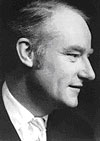|
Francis Crick (1916-2004)
Born on June 16th,1916, in Northampton, England. In 1947, he began his Ph.D. work at the Strangeways
Laboratory, Cambridge, with Arthur Hughes. There Crick and Hughes studied
the physical properties of cytoplasm in the cultured fibroblast cells. After the war he tried to construct a physical model
of the DNA together with James Watson. Based on X-ray diffraction data
Watson and Crick believed the model had to be helical. Watson and Crick
got a much needed clue upon reading Chargaff's paper on one-to-one adenine
to thymine and cytosine to guanine ratios. Crick finally left Cambridge Laboratories in 1976 to become Kieckhefer Professor at Salk Institute for Biological Studies in San Diego, California. It was there that Crick began his present project of the study of the brain. Died on July 29th 2004 in San Diego, USA. |
